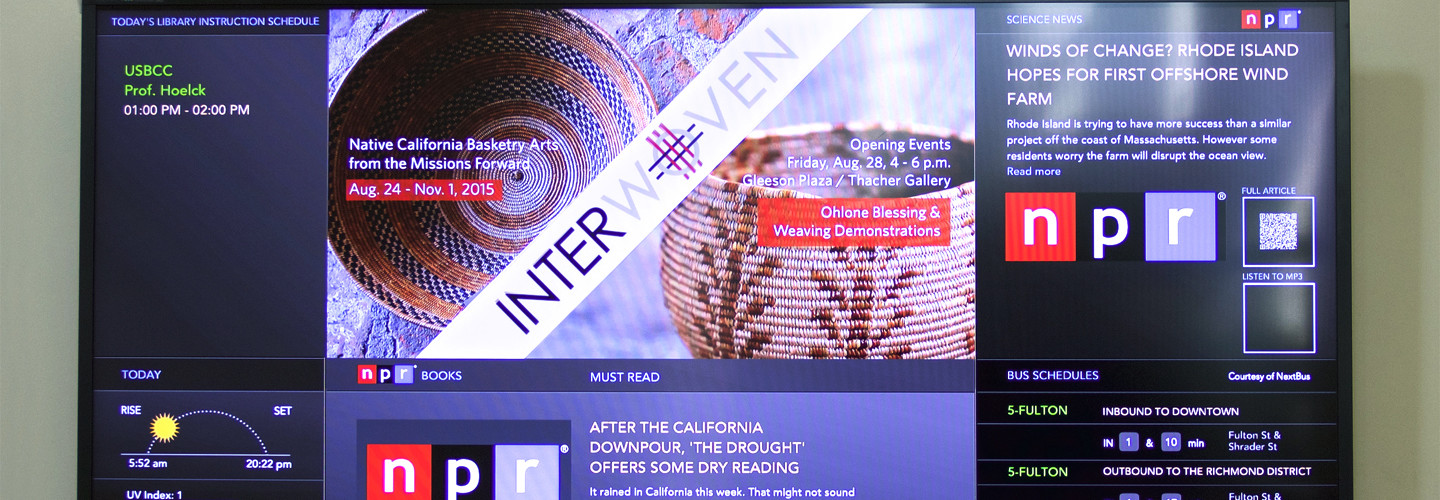Get Smart: Better Ideas for Digital Signage Content
A successful digital signage implementation should always include or incorporate a solid content strategy. The key to developing that strategy lies in well thought out information design. Having good content but displaying it badly is the same as not having good content, which can lead to communication failures, despite the costly investment involved in equipment installation.
At the University of San Francisco, we currently deploy content to more than 50 screens, including iPads, projectors and video walls, across multiple campuses. Our first problem: how can we create content that is interesting and useful to a youth-oriented audience?
Fresh Digital Content Catches Eyes
Let’s be honest: Educational institutions, even large universities, do not have the internal resources required to create content for digital signage. So the question becomes, how does a small team develop compelling, fresh content on an ongoing basis? Leverage existing resources such as events management teams, graphics services departments, social media outlets and external free content creators.
Social media is a great source of content that appeals a very youth-oriented audience, mostly college students who are younger than 21 years old and high school students who participate in campus tours. Social media — Facebook, Instagram, Twitter and curation platforms such as Scoop.it — are a double-edged sword, however. Many university departments start social media accounts, but few end up keeping them fresh and up to date. Stale social media content leaves a bad impression and can even affect a university’s credibility. Someone also must ensure all posted content is appropriate for all viewing audiences.
Another way to add variety and interest to a campus-wide digital signage communications network is to deploy location specific content. Besides the general information that gets delivered to all screens campus wide, such as ads and announcements, some screens can display content that is of specific interest in particular locations. For example, in USF’s Gleeson Library, we added NPR book reviews and the library blog, and in the School of Management, we provided stock and market related content.
Learning to Develop Effective Content
Once the team decides on content sources, the next question is how to deliver content to screens in a way that ensures it is easy to consume? Don’t overwhelm your audience by providing them with too much content at one time. Look first to design a clean layout and take into consideration the locations of all screens.
Certainly, screen location will affect how information is presented. Screens should be installed so that they are easily viewable, in locations with good foot traffic, or where audiences tend to congregate. Understanding the audience will help your team determine how much content to have on a screen at any given time. We found that we could communicate successfully by displaying more content regions on screens that were installed in lobbies and waiting areas, and fewer in places where there was only pass-by traffic.
As a designer, my general approach to digital signage content is for fast consumption, treating it as if it were being displayed on highway billboards. Screen size, height and distance and length of content all affect legibility and understanding. When working with external content contributors, such as graphics services departments, we found that training was very important. Simply stated, our audience does not have the time or the patience for very text heavy ads, or long videos. Keep it short, and you have a better chance of engaging your audiences and getting your messages across.
Ultimately, no matter what content you decide to leverage, you will want to make sure that it is fresh, interesting, and easily consumed. Your audience wants to know what is going on around campus, whether the messaging relates to student events, announcements, social media, new courses offered, or just a snapshot of campus life. At the same time, your audience is busy and always on the move. You only have a split second to capture their attention, so strive to make it count. Don’t lose them with poor content, or good content that is poorly presented. Otherwise, that big investment you made just went to waste.
Author Selin Ozguzer will co-present a general conference seminar at EduComm Expo 2015, “Deploying the Right Content Strategies for Higher Ed Institutions,” from 10 to 11 a.m. Oct. 1 at the Georgia World Congress Center in Atlanta. For more information about EduComm Expo or to register for this event visit EduCommExpo.com.








